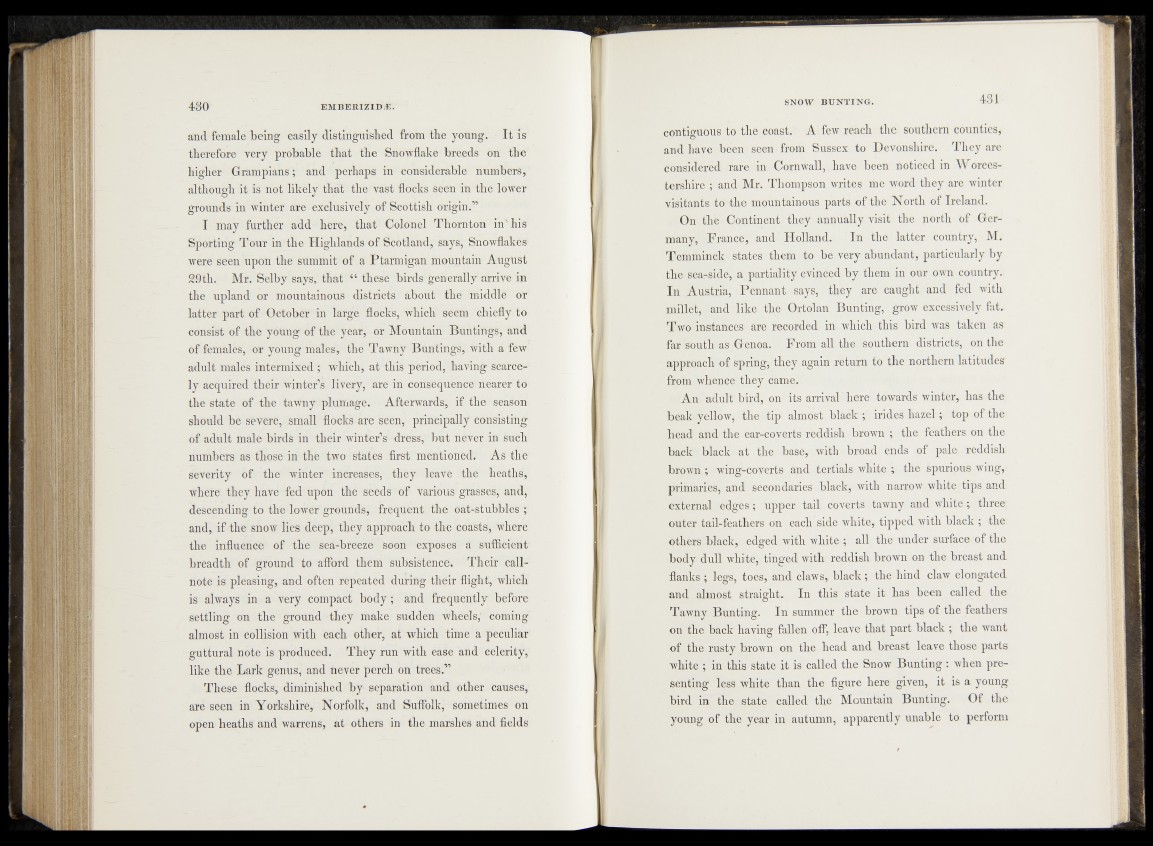
and female being easily distinguished from the young. I t is
therefore very probable that the Snowflake breeds on the
higher Grampians; and perhaps in considerable numbers,
although it is not likely that the vast flocks seen in the lower
grounds in winter are exclusively of Scottish origin.”
I may further add here, that Colonel Thornton in' his
Sporting Tour in the Highlands of Scotland, says, Snowflakes
were seen upon the summit of a Ptarmigan mountain August
29th. Mr. Selby says, that “ these birds generally arrive in
the upland or mountainous districts about the middle or
latter part of October in large flocks, which seem chiefly to
consist of the young of the year, or Mountain Buntings, and
of females, or young males, the Tawny Buntings, with a few
adult males intermixed which, at this period, having scarcely
acquired their winter’s livery, are in consequence nearer to
the state of the tawny plumage. Afterwards, if the season
should be severe, small flocks are seen, principally consisting
of adult male birds in their winter’s dress, but never in such
numbers as those in the two states first mentioned. As the
severity of the winter increases, they leave the heaths,
where they have fed upon the seeds of various grasses, and,
descending to the lower grounds, frequent the oat-stubbles ;
and, if the snow lies deep, they approach to the coasts, where
the influence of the sea-breeze soon exposes a sufficient
breadth of ground to afford them subsistence. Their call-
note is pleasing, and often repeated during their flight, which
is always in a very compact body ; and frequently before
settling on the ground they make sudden wheels,' coming
almost in collision with each other, at which time a peculiar
guttural note is produced. They run with ease and celerity,
like the Lark genus, and never perch on trees.”
These flocks, diminished by separation and other causes,
are seen in Yorkshire, Norfolk, and Suffolk, sometimes on
open heaths and warrens, at others in the marshes and fields
contiguous to the coast. A few reach the southern counties,
and have been seen from Sussex to Devonshire. They are
considered rare in Cornwall, have been noticed in Worcestershire
; and Mr. Thompson writes me word they are winter
visitants to the mountainous parts of the North of Ireland.
On the Continent they annually visit the north of Germany,
France, and Holland. In the latter country, M.
Temminck states them to be very abundant, particularly by
the sea-side, a partiality evinced by them in our own country.
In Austria, Pennant says, they are caught and fed with
millet, and like the Ortolan Bunting, grow excessively fat.
Two instances are recorded in which this bird was taken as
far south as Genoa. From all the southern districts, on the
approach of spring, they again return to the northern latitudes
from whence they Came.
An adult bird, on its arrival here towards winter, has the
beak yellow, the tip almost black ; irides hazel; top of the
head and the ear-coverts reddish brown ; the feathers on the
back black at the base, with broad ends of pale reddish
brown ; wing-coverts and tertials white ; the spurious wing,
primaries, and secondaries black, with narrow white tips and
external edges; upper tail coverts tawny and white; three
outer tail-feathers on each side white, tipped with black ; the
others black, edged with white ; all the under surface of the
body dull white, ting’ed with reddish brown on the breast and
flanks ; legs, toes, and claws, black; the hind claw elongated
and almost straight. In this state it has been called the
Tawny Bunting. In summer the brown tips of the feathers
on the back having fallen off, leave that part black ; the want
of the rusty brown on the head and breast leave those parts
white ; in this state it is called the Snow Bunting : when presenting
less white than the figure here given, it is a young
bird in the state called the Mountain Bunting. Of the
young of the year in autumn, apparently unable to perform